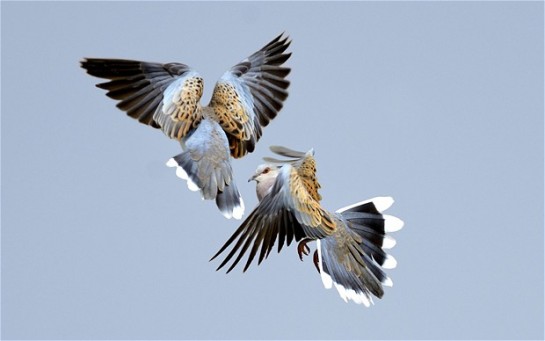Birds & People, a new book by Mark Cocker, examines man’s complex relationship with birds. In this extract he highlights the plight of two species whose very existence is under threat and two further stories of recovery that provide hope for the future.

The European turtle dove has been hunted since the days of ancient Egypt to the extent that its numbers are in serious decline Photo: David Tipling
The European turtle dove (Streptopelia turtur) is one of the most beautiful of all Eurasian pigeons, whose emollient purring song is the colour of ripening grain made audible. There even seems to be something in the turtle dove’s aesthetic appeal that hints at the fine quality of its flesh. Across almost its whole Eurasian range, this 4oz bird has been relished as food. There are 4,500-year-old Egyptian wall reliefs of doves being trapped in nets and with the development of new technologies the slaughter has intensified.
The place most notorious for dove hunting is probably Malta. The small Mediterranean island has a sophisticated attachment to bird trapping and hunting, which, for many male Maltese, are a source of recreation, a statement of both national and gender-oriented identities and a way of maintaining long-established cultural traditions. While hunting was once a major source of subsistence protein, rising standards of living have not seen the activity substantially diminish. For the last 25 years there have been between 14,000 and 17,000 registered hunters or trappers (in a total population of about 350,000). Their cumulative bag, scattered indiscriminately across scores of species, most of which are not eaten, was assumed in 1990 to be between 2.6 million and 5.8 million birds. In that year, the annual turtle dove kill was put at 160,000 - 480,000 birds, although this has since declined substantially and this part of the bag at least enjoyed the rationale of the cooking pot.
What is most striking about the continuing slaughter of turtle doves – estimated across the whole European Union as between two and four million birds annually – is its conflict with the logic generated by the species’ massive systemic declines. In the last 30 years the turtle dove across 16 European Union countries has suffered a 70 per cent reduction on its 1980 population. In Britain it is 90 per cent.
Yet under pressure from the highly vocal and important hunting lobby, the Maltese government has sought, since 2004, an exclusion from legislation that bans hunting of declining species. What seems most striking is the frame of argument used to justify the killing of protected species: the Maltese government argued that the turtle dove, while it may be in plight locally, had large (and, it should be added, largely unknown) numbers in countries such as Russia and Turkey. At a global level, therefore, this rendered it a species of least concern. In 2009 the argument was rejected and Malta judged in breach of international legislation by the European Court.
For his part, the Maltese hunter on the ground applied much the same logic. ‘If I don’t shoot it, someone else will, so I’d rather shoot it myself,’ one individual explained when asked why he killed as he did. The argument is revealing for drawing its primary meaning from competition among the hunters, and also for its utter lack of reference to the prey itself. It is, in truth, not a rationale for hunting. That surely requires some imaginative transaction, some ecological linkage, between the hunter and his target. To justify the killing as a means to pre-empt one’s predatory competitors is little more than a charter for the quarry’s eventual extinction.
Source: Telegraph.co.uk
